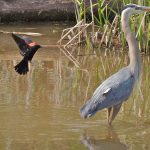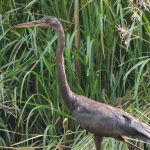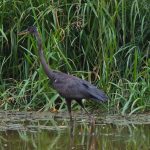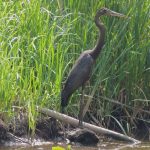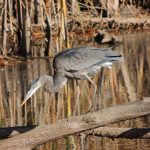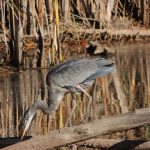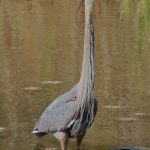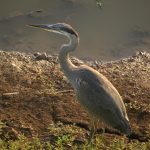August 11 2016. Valley Inn Hamilton ON. There has been quite a bit of buzz in the local birding community about a Great Blue Heron – a melanistic Great Blue perhaps. Or did it get dunked in old oil somehow ? That was the question. A debate followed for a day or two and in the end I think the consensus was for melanism over motor oil. “ Melanism is a development of the dark-coloured pigment melanin in the skin or its appendages and is the opposite of albinism. “ Thanks internet.
Oiled versus melanism has a bit of history among birders. Every now and then a puzzle of a bird turns out to have been oiled somehow. Goodness knows we’ve all seen sad pictures of hapless waterfowl who unwittingly (and usually terminally) become engulfed in oil. Ken Kauffman, eminent American birder and author of one of the best field guides to North American birds, tells about rushing to Brigantine Wildlife Reserve, New Jersey, to see a Spotted Redshank, a lanky, dark-plumaged European shorebird which would be a rare treat for those who work hard at catching up with random rarities. On arrival at Brigantine (by hitchhiking – it was 1973) Kauffman was surprised to find no other birders; something was clearly wrong. Was the redshank long gone? Checking the guest book at the visitor information centre, he found and read a long, painstakingly careful analysis by one of America’s pre-eminent ornithologists of the day concluding that the Spotted Redshank was actually a Greater Yellowlegs (not a rarity) that had somehow settled into an oily pond and besmeared its plumage.
I spent a bit of time watching our unusual heron today and my preference is for an unspoiled bird that is just a little darker than normal; I don’t think it has had an oily mishap. All of its feathers appear to be clean and in good condition, not matted or misshapen; Its face and bill are the right colour for a Great Blue Heron, not in the slightest bit discoloured and; It appears to be behaving normally. Melanistic yes, oiled no.
So what do we have, other than an intriguing bird of the day? Certainly a young heron hatched this year; it is probably less than four months old and still dressed in its first basic plumage. Young Great Blue Herons are normally a dark, rather monochromatic, brownish. Today’s bird is not so different from ‘normal’, it’s a bit darker than average and lacking some of the pale brownish definition on feathers of the neck and wing that might otherwise make it more mottled. By late this year the grey-blue adult feathers will start to appear. It will be interesting to see if this bird survives the winter to return to this area and if it does, whether it shows any discernable darkness in its adult plumage.
This gallery (visible only on the website, not if you’re reading this as an email.) holds a number of shots of today’s bird and a couple of other youngsters and (for interest’s sake) some mature adults. See if you like my conclusions.
